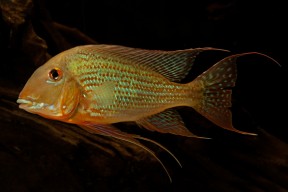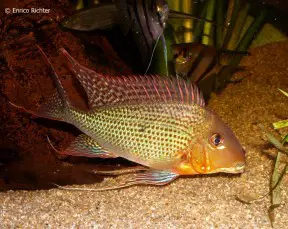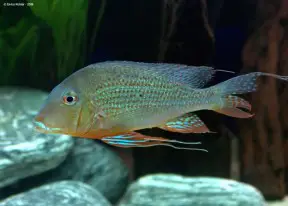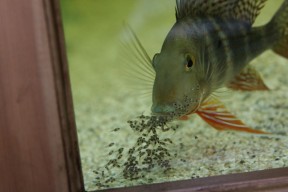Geophagus altifrons
Etymology
Geophagus: from the Greek geo, meaning ‘earth’, and phagos, meaning ‘ to eat’.
altifrons: from the Latin alto, meaning ‘high, tall’, and frons, meaning ‘forehead, front’.
Classification
Order: Perciformes Family: Cichlidae
Distribution
Described from ‘Barra do Rio-negro’ which corresponds to the Fort of São José da Barra do Rio Negro, built by the Portugese at the site of what is now the city of Manaus, Amazonas state, Brazil.
Since then it’s been recorded from most tributary drainages of the middle-to-lower Amazon basin including the Paru, Xingu, Tapajós, Trombetas, Madeira, Negro and Purus (the fish from the rio Tocantins traded as G. sp. aff. altifrons ‘Tocantins’ is now described as G. neambi).
Different populations exhibit variations in colour and patterning which has lead to unconfirmed speculation that the species as currently accepted might represent a complex of closely-related, but distinct, taxa.
It’s also been introduced to some streams and inland reservoirs in Singapore where it appears to be thriving.
Habitat
Predominantly found in the lower reaches of rivers, appearing to be restricted by the first stretch of rapids encountered, and has also been collected from floodplain lakes in Várzea (literally ‘flooded forest’) regions.
It’s said to show a preference for clear and black water environments as opposed to turbid ‘white’ waters and tends to inhabit gently sloping marginal zones around shores or islands with substrates of sand, fine gravel and mud.
Depending on locality other habitat features can include scattered rocks, submerged tree roots and branches.
G. altifrons occurs sympatrically with literally hundreds of other species across its range but as an example some of those inhabiting the rio Purus include Acestrorhynchus falcatus, Leporinus friderici, Aphyocharax alburnus, Hemigrammus ocellifer, Hyphessobrycon bentosi, Leptagoniates pi, Moenkhausia oligolepis, Prionobrama filigera, Tetragonopterus argenteus, Triportheus angulatus, Thoracocharax stellatus, Corydoras armatus, C. trilineatus, Hemiodontichthys acipenserinus, Lamontichthys filamentosus, Otocinclus vittatus, Rineloricaria lanceolata, Bujurquina sp. cf. syspilus and Colomesus asellus.
Maximum Standard Length
200 – 225 mm.
Aquarium SizeTop ↑
An aquarium with a base measuring 180 ∗ 60 cm or more is required to house a group long-term.
Maintenance
The most essential item of décor in a set-up for this species is a soft, sandy substrate so that the fish can browse naturally (see ‘Diet’).
Coarser materials such as gravel or small pebbles can inhibit feeding, damage gill filaments and even be ingested with the potential of internal damage or blockages.
Additional furnishings are as much a case of personal taste as anything else but the most favoured set-ups tend to feature relatively dim lighting plus some chunks of driftwood and scattered roots or branches.
Leaf litter is a typical feature of the natural environment but not really recommended in aquaria because the feeding behaviour of Geophagus spp. tends to cause an excess of partially-decomposed material in suspension which not only looks unsightly but can block filter and pump mechanisms.
One or two flattish, water-worn rocks can also be included to provide potential spawning sites if you wish.
Water quality is of the utmost importance since these cichlids are extremely susceptible to deteriorating water quality and swings in chemical parameters so should never be introduced to a biologically immature aquarium.
The best way to achieve the desired stability is to over-filter the tank using a combination of external canister filters and/or a sump system and perform minimum weekly water changes of 50-70%.
If the maintenance regime is insufficient health issues such as head and lateral line erosion or stunted growth can occur.
Mechanical filtration should also be tailored to trap small particles stirred up by the fish as sand can cause blockages and wearing issues with filter mechanisms if allowed to continually run through the system.
High flow rates should be avoided so position filter returns accordingly.
Water Conditions
Temperature: 26 – 32 °C
pH: In its natural waters pH values of 4.8 – 6.6 have been recorded and wild-collected specimens are likely to do best within this range. Captive-bred examples can normally be maintained under neutral conditions.
Hardness: Ideally 0 – 90 ppm.
Diet
Geophagus spp. are benthophagous by nature, employing a method of feeding whereby mouthfuls of substrate are taken and sifted for edible items with the remaining material expelled via the gill openings and mouth.
For this reason they’re commonly termed ‘eartheaters’ and the provision of a suitable substrate is essential to their long-term well-being.
Once settled they readily rise into the water column when food is introduced but continue to browse normally at other times.
The stomach contents of wild specimens mostly comprise small aquatic and terrestrial invertebrates, plant material in the form of seeds, organic detritus and sediment.
Even as adults these cichlids seem unable to properly ingest larger food items meaning the diet should contain a variety of high quality, fine-grade prepared foods plus small live or frozen bloodworm, Tubifex, Artemia, mosquito larvae, etc.
At least some of the dried products should contain a high proportion of vegetable matter such as Spirulina or similar.
Home-made, gelatine-bound recipes containing a mixture of dried fish food, puréed shellfish, fresh fruit and vegetables, for example, are proven to work well and can be cut into bite-sized discs using the end of a sharp pipette or small knife.
Rather than a single large meal offer 3-4 smaller portions daily to allow natural browsing behaviour as this seems to result in the best growth rate and condition.
Behaviour and CompatibilityTop ↑
Unless breeding this species is surprisingly peaceful and will not predate on fishes larger than a few millimetres in length.
Suitable tankmates are far too numerous to list but include most peaceful species enjoying similar environmental conditions.
Best avoided are aggressive or territorial substrate-dwelling species, or those requiring harder water.
Some aquarists keep Geophagus spp. alongside freshwater stingrays of the genus Potamotrygon which in many cases has proven successful but in some has resulted in them disappearing at night (!).
G. altifrons is gregarious and tends to exist in loose aggregations unless spawning, with juveniles in particular displaying strong grouping berhaviour.
A group of 5-8 individuals should be the minimum purchase and these will form a noticeable dominance hierarchy.
When maintained in smaller numbers weaker specimens can become the target of excessive antagonism by dominant individuals or the group may fail to settle and behave nervously.
Sexual Dimorphism
No external differences have been observed except during spawning when the ovipositor of the female is visible.
Reproduction
Substrate-spawning, ovophilous, biparental mouthbrooder that has been bred on numerous occasions in aquaria.
There doesn’t appear to be any particular trigger for the spawning process with the main requirements being good diet and stringent maintenance regime involving relatively large weekly water changes.
Since accurate sexing is essentially impossible it’s best to begin with a group of young fish and allow pairs to form naturally.
A degree of patience is also required since it can be at least a year until they become sexually mature.
Courtship is relatively unobtrusive consisting of fin flaring, circling, gaping and head jerking displays, and when ready to spawn a pair will select a suitable site.
This is normally a piece of décor such as a flat rock or section of driftwood although it’s not unknown for the base of the aquarium to be used, and once chosen the area is then cleaned and defended against intruders.
Spawning occurs in typical substrate–spawning fashion with the female laying one or more rows of eggs before the male moves in to fertilise them, the process being repeated numerous times over a period of several hours.
Maximum brood size is around 200 eggs which are normally taken up by the female though on rare occasions both adults may be involved from the start.
Some males may become aggressive post-spawning and drive the female away to care for the eggs alone, but the most common scenario involves her holding the fry while he defends the surrounding territory.
Once the fry are swimming freely brood care is shared although this also varies depending on the male with some individuals becoming involved earlier and others not at all.
The parents may participate in mouthbrooding duties simultaneously or by exchanging the entire brood on a more-or-less daily basis, the transfer usually occurring in a sheltered location such as a depression in the substrate.
When not brooding the adults will normally feed, and may even take some small morsels while holding fry.
At 77 – 82.4°F/25 – 28°C the fry become free swimming at 8-11 days of age and the parents begin to release them to feed, initially with caution but for increasingly longer periods. If danger is sensed the fry are shepherded back into the adults’ mouths, with rapid movement of the ventral fins appearing to act as a signal.
As time elapses and the fry gorw they may only return to their parents’ mouths at night while the size of the territory becomes correspondingly larger.
They’re easily-fed, accepting good quality powdered dry foods, Artemia nauplii, microworm, etc., as soon as the free-swimming stage is reached.
If maintaining the adults in a community situation it’s recommended to remove brooding females as the fry become easy prey for other fishes, including conspecifics, once released.
NotesTop ↑
Despite its designation as type species this is among the most frequently-misidentified members of the genus.
This is in part because its natural distribution was earlier considered even more extensive than the still-substantial range recognised today, with populations from the Río Orinoco, Guianas and rio Tocantins now recognised as species in their own right.
Further confusion has been caused by undescribed Geophagus species from various parts of the Amazon basin being traded as geographic forms of G. altifrons or G. sp. aff. altifrons despite possessing prominent midlateral markings or vertical body stripes, whereas in G. altifrons sensu stricto these features are greatly reduced and absent, respectively.
It’s a member of the putative G. surinamensis ‘group’ of closely-related species within the genus and can be identified by a combination of characters including: no dark preopercular marking; no vertical bars on the flanks even when stressed or preserved; dark midlateral marking reduced to 1-2 scales width or even absent in adults.
The latter is important because it’s unique to the species and can be used to distinguish it from all other congeners as things stand.
Juveniles are very difficult to identify though as the size of the midlateral markings is comparable to that seen in other species at the same age.
Representatives of the G. surinamensis assemblage are diagnosed by their relatively deep head and body shape, possession of a variably-sized dark spot on each flank and presence or absence of a small, dark preopercular marking.
There are currently thirteen described members but diversity is predicted to eventually prove much greater with a number of undescribed forms known some of which, such as G. sp. ‘orange head’ and G. sp. ‘Pindare’, are regularly available in the aquarium trade.
The described members of the group are G. abalios, G. altifrons, G. brachybranchus, G. brokopondo, G. camopiensis, G. dicrozoster, G. megasema, G. neambi, G. parnaibae, G. proximus, G. surinamensis, G. sveni and G. winemilleri.
Only five Geophagus species aren’t included, namely G. argyrostictus, G. gottwaldi, G. grammepareius, G. harreri and G. taeniopareius.
These are most easily separated on the basis that they all possess a complete infraorbital stripe but oddly have not had their own group name assigned, usually being referred to simply as ‘non-G. surinamensis group’ species.
Accurate identification of G. surinamensis group members has been problematic for a number of reasons, not least that prior to Kullander (1986) G. surinamensis itself was thought to range throughout the Orinoco, Amazon and Guianas river systems but is now considered endemic to the Rio Surinam and Ri0 Maroni/Marowijne watersheds in eastern Suriname.
Several former ‘populations’ have thus been described as species in their own right since the turn of the century, meaning older literature can be somewhat unreliable.
Further, the majority of Geophagus species in the hobby are sold as G. surinamensis regardless of origin – a situation which continues to cause confusion and exacerbated by the fact that juveniles of most are virtually identical.
G. surinamensis is in fact almost never traded and very few privately-owned specimens exist.
The number of species awaiting description is unconfirmed but it seems feasible that certain rivers within the Río Orinoco, rio Amazonas, rio Tocantins and rio Parnaíba basinsm, plus coastal drainages of the Guianas, contain one or two endemic forms.
Of those known in the aquarium hobby some are traded as G. sp. aff. altifrons which can be misleading as they don’t always resemble that species.
More preferable is to label with locality data when available.
The genus Geophagus was rediagnosed by Kullander (1986) who restricted it to include only those species with paired caudal extensions to the swimbladder lined by 6-12 epihemal ‘ribs’ plus a greater number of caudal than abdominal vertebrae.
Some former species were moved into the resurrected genus Satanoperca while others, such as the ‘Geophagus‘ brasiliensis and ‘G.‘ steindachneri groups represent distinct groupings still in need of definitive classification.
Geophagus and a number of related genera are often included in the putative subfamily Geophaginae.
Kullander (1998) conducted a morphology-based phylogenetic study in which the neotropical Cichlidae was divided into six subfamilies of which the Geophaginae contained 16 genera divided among three ‘tribes’:
Acarichthyini – Acarichthys and Guianacara.
Crenicaratini – Biotoecus, Crenicara, Dicrossus and Mazarunia.
Geophagini – Geophagus, Mikrogeophagus, ‘Geophagus‘ brasiliensis group, ‘Geophagus‘ steindachneri group, Gymnogeophagus, Satanoperca, Biotodoma, Apistogramma, Apistogrammoides and Taeniacara.
Later molecular studies by Farias et al. (1999, 2000, 2001) resulted in the additions of Crenicichla and Teleocichla to the Geophaginae, a result supported by López-Fernández et al. (2005) who conducted the most detailed molecular analysis of the grouping to date including 16 of the 18 genera and 30 species.
However their conclusions regarding interrelationships between genera did vary somewhat from previous hypotheses and can be summarised by the following loosely-defined groups:
– a weakly-supported sister group relationship between Acarichthys and Guianacara.
– a well-supported ‘Satanoperca clade‘ comprising Satanoperca, Apistogramma, Apistogrammoides and Taeniacara.
– a ‘big clade‘ with Geophagus, Mikrogeophagus, ‘Geophagus‘ brasiliensis group, ‘Geophagus‘ steindachneri group, Gymnogeophagus, Biotodoma, Crenicara and Dicrossus.
– a ‘crenicarine clade‘ with Biotoecus and Crenicichla.
No representatives of Teleocichla or Mazarunia were included in the study but the former is well-established as sister to Crenicichla while the latter has grouped closely with Dicrossus and Crenicara in earlier works.
The other main conclusions of the paper are confirmation that Geophaginae is a monophyletic group exhibiting strong signs of having undergone rapid adaptive radiation.
References
- Heckel, J. J., 1840 - Annalen des Wiener Museums der Naturgeschichte 2: 325-471
Johann Natterer's neue Flussfische Brasilien's nach den Beobachtungen und Mittheilungen des Entdeckers beschrieben (Erste Abtheilung, Die Labroiden). - dos Anjos, H. D. B., J. Zuanon, T. M. P. Braga and K. N. S. Sousa, 2008 - Check List 4(2): 198-213
Fish, upper Purus River, state of Acre, Brazil. - Farias, I. P., G. Ortí and A. Meyer, 2000 - The Journal of Experimental Zoology 288(1): 76-92
Total evidence: molecules, morphology, and the phylogenetics of cichlid fishes. - Farias, I. P., G. Ortí, I. Sampaio, H. Schneider and A. Meyer, 1999 - Journal of Molecular Evolution 48(6): 703-711
Mitochondrial DNA phylogeny of the family Cichlidae: monophyly and fast molecular evolution of the Neotropical assemblage. - Farias, I. P., G. Ortí, I. Sampaio, H. Schneider and A. Meyer, 2001 - Journal of Molecular Evolution 53(2): 89-103
The cytrochrome b gene as a phylogenetic marker: the limits of resolution for analyzing relationships among cichlid fishes. - Kullander, S. O., 1986 - Swedish Museum of Natural History, Stockholm: 1-431
Cichlid fishes of the Amazon River drainage of Peru. - Kullander, S. O. and H. Nijssen, 1989 - E.J. Brill, Leiden, The Netherlands: i-xxxii + 1-256
The Cichlids of Surinam. - Lucinda, P. H. F., C. A. S. de Lucena and N. C. Assis, 2010 - Zootaxa 2429: 29-42
Two new species of cichlid fish genus Geophagus Heckel from the Rio Tocantins drainage (Perciformes: Cichlidae). - López-Fernández, H. and D. C. Taphorn, 2004 - Zootaxa 439: 1-27
Geophagus abalios, G. dicrozoster and G. winemilleri (Perciformes: Cichlidae), three new species from Venezuela. - López-Fernández, H., R. L. Honeycutt, M. L. J. Stiassny and K. O. Winemiller, 2005 - Zoologica Scripta 34(6): 627-651
Morphology, molecules, and character congruence in the phylogeny of South American geophagine cichlids (Perciformes, Labroidei). - Pereira, P. R., C. S. Agostinho, R. J. de Oliveira and E. E. Marques, 2007 - Neotropical Ichthyology 5(3): 399-404
Trophic guilds of fishes in sandbank habitats of a Neotropical river. - Reis, R. E., S. O. Kullander and C. J. Ferraris, Jr. (eds), 2003 - EDIPUCRS, Porto Alegre: i-xi + 1-729
Checklist of the Freshwater Fishes of South and Central America. CLOFFSCA. - Schindler, I. and W. Staeck, 2006 - Zoologische Abhandlungen (Dresden) 56: 91-97
Geophagus gottwaldi sp. n. - a new species of cichlid fish (Teleostei: Perciformes: Cichlidae) from the drainage of the upper rÃo Orinoco in Venezuela. - Staeck, W. and I. Schindler, 2006 - Zoologische Abhandlungen (Dresden) 55: 69-75
Geophagus parnaibae sp. n. -- a new species of cichlid fish (Teleostei: Perciformes: Cichlidae) from the rio ParnaÃba basin, Brazil.













